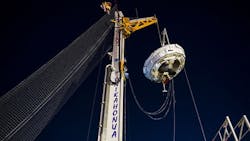NASA Tests 'Flying Saucer' Device for Future Mars Landings
WASHINGTON—NASA launched a giant balloon Monday carrying a kind of "flying saucer" that will test technologies for landing on Mars.
The aircraft is fitted with the largest parachute ever constructed.
After several days of weather-related delays, the helium balloon was launched from a military base in Hawaii and was to rise for about two hours.
It was the second test of the saucer-like device, called the Low-Density Supersonic Decelerator.
During the first test in June 2014, the parachute shredded to pieces on the way down. NASA modified the design.
Since the atmosphere on Mars is so thin, any parachute that helps a heavy, fast-moving spacecraft touch down needs to be especially strong.
NASA figured out how to do this decades ago, beginning with the Viking mission that put two landers on Mars in 1976.
But with the goal of sending humans to Mars in the 2030s, the agency is now testing a more advanced generation of parachute technology, known as the Supersonic Ringsail Parachute.
It could allow even heavier spacecraft—the kind that may have humans and months of food and supplies on board—to land softly.
The test vehicle—the "flying saucer"—weighs 6,808 pounds (3,088 kilograms), or about twice the weight of the kind of robotic rover spacecraft NASA is currently capable of landing safely on Mars.
The parachute, described by NASA's Jet Propulsion Laboratory as "the largest parachute ever deployed," is 100 feet (30 meters) in diameter.
The goal is for the chute to "slow the entry vehicle from Mach 2 to subsonic speeds," NASA said.
The test involves sending the saucer, an inner-tube shaped decelerator and parachute to an altitude of 120,000 feet over the Pacific Ocean with the help of the giant balloon.
The balloon will release the spacecraft and rockets will lift the vehicle even higher, to 180,000 feet, reaching supersonic speeds.
"Traveling at three times the speed of sound, the saucer's decelerator will inflate, slowing the vehicle, and then a parachute will deploy at 2.35 times the speed of sound to carry it to the ocean's surface," NASA said.
The trip down is scheduled to take about 40 minutes.
The new technology is tested at a high altitude because conditions there are similar to the upper atmosphere of Mars.
Copyright Agence France-Presse, 2015
About the Author
Agence France-Presse
Copyright Agence France-Presse, 2002-2025. AFP text, photos, graphics and logos shall not be reproduced, published, broadcast, rewritten for broadcast or publication or redistributed directly or indirectly in any medium. AFP shall not be held liable for any delays, inaccuracies, errors or omissions in any AFP content, or for any actions taken in consequence.
